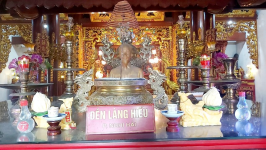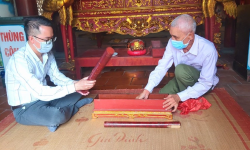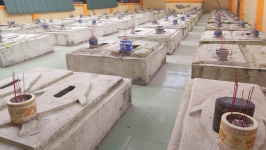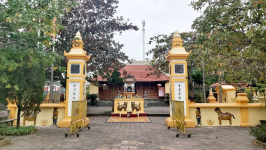




Price: Free
Time to visit a place: 60 phút
Open Time: 7:00 AM - Close Time: 6:00 PM
Address: Nghi Hai Sub-district, Cua Lo Town,
Hieu Village Temple Festival
When the inhabitants of Nghi Hai were floating on the immense sea, catching seafood day and night, sometimes encountering big waves and high winds but the accident was over, they believed in a god to protect them. Therefore, spiritual beliefs are the spiritual support of the inhabitants of Nghi Hai, then the idol "fish man" is like a divine being who saves the seas of fishermen. Therefore, the estuaries along the coast of Vietnam, everywhere, there are temples and shrines to worship "Ca Ong". According to Le Quy Don's "Dai Viet history" or Tran Trong Kim's "Dai Viet history" and Tran Huy Lieu's historical documents on Nghe An, from the 10th to the 14th centuries, Cua Hoi was one of the creek mouths has many domestic and foreign boats trading and catching seafood. Where the Dai Viet national dynasties were interested in building and defending these two estuaries to protect the country. Generals have been rested by fierce battles on this land. Cua Lo and Cua Hoi are rich in seafood resources. The majority of residents come from the North and the South. The population clusters formed from the 14th century onwards all stem from the work of reclaiming wasteland and fishing of residents from many other places to live. Since then, the people here have established temples and shrines to worship such as: Bald Trai pagoda to worship Buddha, Tam Toa temple to worship the holy god, fish temple to worship "his fish" and Hieu village temple.. According to the ordination of King Le Hien Tong, the 44th year of Canh Hung year (ie 1784 solar calendar), the temple of Hieu village existed 228 years ago in the middle of the 17th century. The ordination of King Khai Dinh in the second year. 9(1925) stated:(Cao Son Cao Cac… Ton Than Nguyet Tang Phu Linh… Selling Wings of Thanh Hoang Dai Vuong worshiping God Protecting the Nation…). Based on the content of these 6 ordinations, we can confirm that the Hieu village temple worships a great minister who has helped the country and reclaimed the wasteland to establish the village and the dynasties assigned to the residents of Loc Chau and Loc Hai communes. worship here. Experiencing many changes in history, especially heavily influenced by two wars, the temples and shrines in Nghi Hai area are no longer there. Particularly, the temple of Hieu village is still there, but it is only the old ground and some items have been faded and damaged by time, but are still preserved by the residents here and worshiped every year. According to the elders and based on the ordination, the ancient Hieu village temple has a dragon-shaped curved roof structure, three floors of worship (high and high) with upper and lower halls, lower beams, carved columns. dragon head pattern. In front of the temple, there is a floor of three treasures and a gate with two words "Kai Mon", on the right and right side there is an entrance gate and a couple of parallel sentences with the image of two soldiers wearing hats holding swords standing guard. The temple is located at the grave of the dragon's head, facing Southeast to welcome the breath of life from the sea and estuary, according to feng shui theory, it is really great sand. Unfortunately, the ancient architecture is no more. But up to now, the people of Nghi Hai still keep the 6 religious orders given by the king from the post-Le dynasties to the Nguyen dynasties. In addition, some people here also preserved and preserved a number of worshiping relics of Hoi Trai Pagoda, Tam Toa Palace, Communal House of Hai Commune, Fish Temple and handed over to the management board of Hieu village's temple. These are rare items that need to be preserved for generations to come. The confidence of Nghi Hai residents has become the cultural and spiritual identity of Cua Lo sea area. In order for the spiritual culture and heritage to be perpetuated, Nghi Hai residents wished to rebuild and restore the temple of Hieu village as before. Responding to the earnest wishes of local residents, in early April 2012, Cua Lo Town allowed Nghi Hai ward to start rebuilding the Temple. In the not too distant future, Lang Hieu Temple will be the sights and sights of tourists when they return to Cua Lo and a cultural and spiritual point of the people in the river region.
Distance: 1.09 km
Distance: 1.33 km
Distance: 1.80 km
Distance: 3.63 km
Distance: 3.83 km
Distance: 3.95 km
Distance: 4.11 km
Distance: 4.14 km
Distance: 4.35 km
Distance: 930 m
Distance: 990 m
Distance: 1.04 km
Distance: 1.25 km
Distance: 1.37 km
Distance: 1.77 km
Distance: 1.79 km
Distance: 1.80 km
Distance: 4.49 km
Distance: 4.65 km
Distance: 4.90 km
Distance: 5.28 km
Distance: 5.55 km
Distance: 5.68 km
Distance: 6.09 km
Distance: 6.11 km
Distance: 6.56 km
Distance: 6.97 km
Distance: 0 m
Distance: 0 m
Distance: 710 m
Distance: 960 m
Distance: 1.30 km
Distance: 2.02 km
Distance: 2.89 km
Distance: 4.78 km
Distance: 4.80 km
Distance: 5.45 km
Distance: 5.93 km
Distance: 6.47 km
Distance: 6.87 km
Distance: 6.88 km
Distance: 7.08 km
Distance: 7.26 km
Distance: 7.31 km
Distance: 7.71 km
Distance: 2.93 km
Distance: 4.75 km
Distance: 5.39 km
Distance: 5.63 km
Distance: 5.87 km
Distance: 5.94 km
Distance: 5.97 km
Distance: 6.20 km
Distance: 6.38 km
Distance: 7.70 km
Distance: 8.41 km
Distance: 11.15 km
Distance: 11.56 km
Distance: 11.57 km
Distance: 11.63 km
Distance: 11.66 km
Distance: 11.75 km
Distance: 12.32 km


